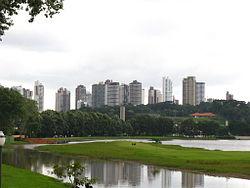List of cities in Brazil by population: Difference between revisions
| Line 21: | Line 21: | ||
[[Image:Asanorte2.jpg|thumb|250px|4 - [[Brasília]]]] |
[[Image:Asanorte2.jpg|thumb|250px|4 - [[Brasília]]]] |
||
[[Image:Beira-mar em Fortaleza.jpg|thumb|250px|5 - [[Fortaleza]]]] |
[[Image:Beira-mar em Fortaleza.jpg|thumb|250px|5 - [[Fortaleza]]]] |
||
[[Image:Belo |
[[Image:Belo horizonte1.jpg|thumb|250px|6 - [[Belo horizonte]]]] |
||
[[Image:Curitiba From Barigui Park.jpg|thumb|250px|7 - [[Curitiba]]]] |
[[Image:Curitiba From Barigui Park.jpg|thumb|250px|7 - [[Curitiba]]]] |
||
Revision as of 20:31, 18 September 2010

This is a list of the largest cities in Brazil. Brazil has a relatively high reported level of urbanization, with 8 out of every 10 Brazilians living in cities. The criteria used by the IBGE (Brazilian Institute of Geography and Statistics) in determining whether households are urban or rural, however, is based on political divisions, not on the built environment.
A town is any seat of a district (the lowest political division); a city is the seat of a municipality. Nowadays, the country has more than 5,564 municipalities.[1] About 81.3% of Brazilians live in an urban area.[2]
State capitals are usually also the largest city in their respective state, exceptions being Vitória in Espírito Santo, and Florianópolis, the capital of Santa Catarina; there are also non-capital metropolitan areas in São Paulo (Campinas, Santos, Paraíba Valley), Minas Gerais (Vale do Aço), Rio Grande do Sul (Sinos Valley), Paraíba (Campina Grande) and Santa Catarina (Joinville & Itajaí Valley). Most of the non-capital large cities in Brazil are in the states of São Paulo, Minas Gerais, Santa Catarina, Paraná and Rio de Janeiro.
Some of the main Brazilian cities are planned cities; the most famous of these is the capital city, Brasília, which represents the Modernist school of architecture and urbanism.
Top 115 most populous cities and state capitals
This list here of the 115 most populous cities is based on the population of the município where the city is located, rather than its metropolitan area.
- State capitals are in bold. Second Rank* is by capitals and non-capitals. Palmas is the only state capital not listed.





Largest metropolitan areas
Currently, as of 2009[update], IBGE officially recognizes 15 major RMs (Região Metropolitana; Metropolitan Region in English), where approximately 32% of the Brazilian population (55 million people out of 180 million) live. These RMs are responsible for approximately half of the Brazilian GDP and more than 70% of the Brazilian annual industrial production.
- Metropolitan areas of state capitals are in bold.
1 Data of 2007.
2 Data of 2008.
3 Data of 2009.
References
- ^ "Territorial units of the municipality level" (in Portuguese). Brazilian Institute of Geography and Statistics. 2008. Retrieved 2008-06-03.
- ^ [1]
- ^ a b "Brazilian Institute of Geography and Statistics". 2008. Retrieved 2007-06-27.
@Cidades
